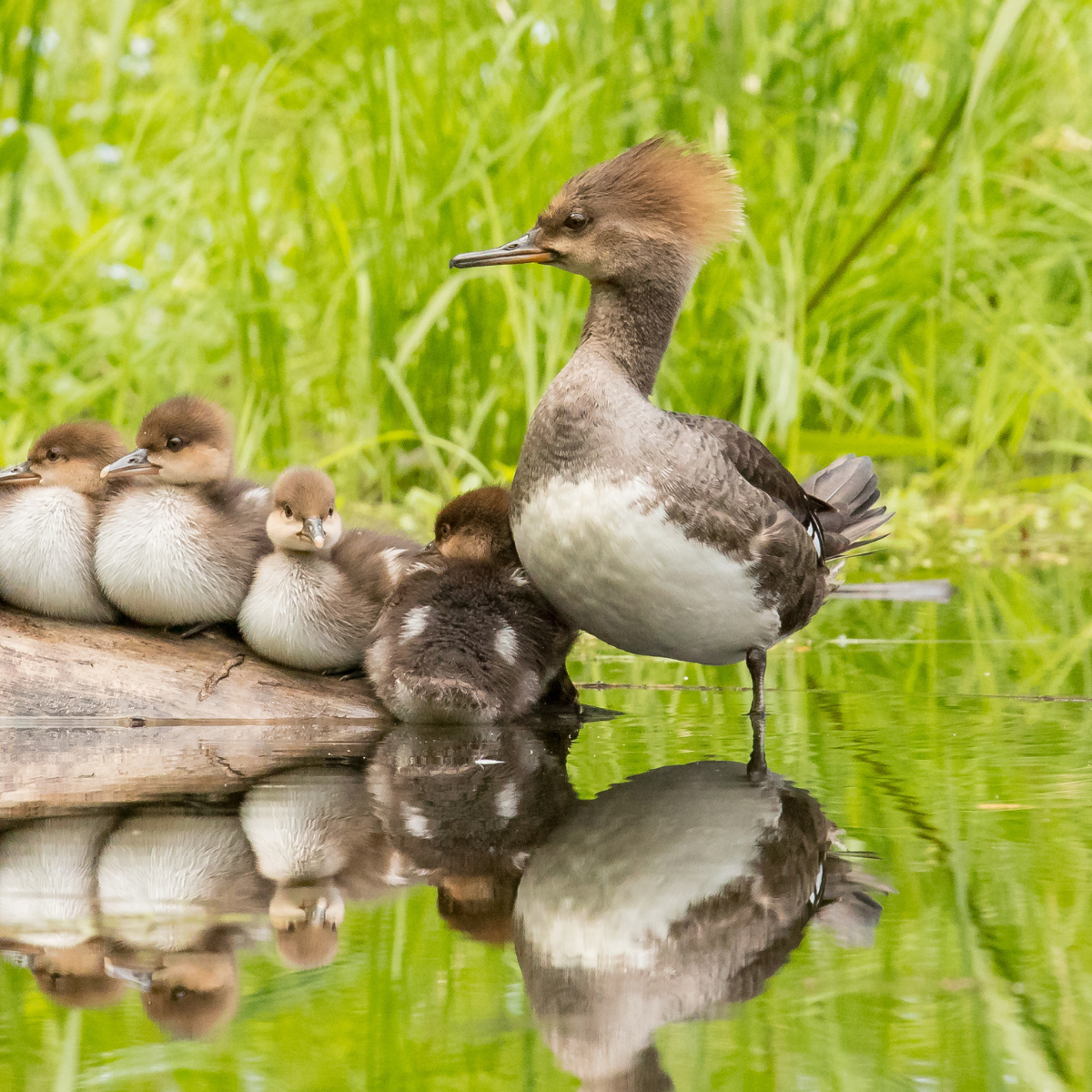Bird of the Month: Hooded Merganser
Written by Andy McCormick
Andy McCormick, 2024 Audubon Washington Helen Engle Volunteer of the Year
Our smallest merganser, the Hooded Merganser prefers ponds in wooded areas, swamps, and tidal creeks.
Its regal head ornament is the most obvious aspect of the drake Hooded Merganser. The hood is more like a white comb outlined in black which is often raised during the courtship period between November and April and relaxed at other times of the year. When the hood is retracted the duck’s head has the look of an anvil with a white line through it. Black feathers cover the head and back of the male and the buffy sides are outlined by black and white stripes on the chest. Similar stripes on the tertials drape across the duck’s back. The overall coloration of the female is a more muted brown; however, many observers agree that the female’s wispy brown crest displays a lovely translucence when backlit (Dunne). The call of the Hooded Merganser is a bark-like grunt given in spaced notes. Photos, videos, and audio recordings can be accessed at the Macaulay Library.
Hooded Merganswer
Scientific Name: Lophodytes cucullatus
Length: 18”
Wingspan: 24”
Weight: 1.4 oz (620 g)
AOU Alpha Code: HOME
CAVITY NESTER
The Hooded Merganser is a duck of woodlands and like the Wood Duck it nests in tree cavities. It prefers quiet woody ponds and is seldom seen in salt water. Like other mergansers the Hooded Merganser has a long, thin, serrated bill which helps it grab and hold onto prey, but it differs from the others by eating a more variable diet which in addition to small fish includes crustaceans and aquatic insects.
In general, Hooded Mergansers prefer to nest in a natural tree cavity that is located near water, but they will also occasionally use nest boxes. Usually, 10-12 eggs are deposited, but they might not be from the same female. Like other cavity-nesting ducks females will deposit eggs in the nests of other Hooded Mergansers, Wood Ducks, or other ducks. Incubation is by the female for about one month, ranging from 26 to 41 days (Kaufman). The young are precocious and take to water within a day of hatching usually by dropping from the nest cavity into the water (Bent).
MIGRATION AND DISTRIBUTION
Hooded Mergansers are early spring migrants arriving in woodlands south of the boreal forest. They will begin nesting within days of ponds being ice-free. They remain on the nesting grounds as long as possible in fall to just before ponds freeze over. Many remain as year-round residents in the more temperate zones such as in the Pacific Northwest. There is a large population of Hooded Mergansers in eastern North America with the highest density residing in the Great Lakes region.
The population of Hooded Mergansers is stable and there are no management plans dedicated for them. However, recommendations for supporting their preferred nesting habitat include preserving woodlands in flood plains (Dugger). During the past century as eastern forests have re-established in previously logged areas, snags and trees with cavities have provided an increase in suitable habitat for the Hooded Merganser.
A NOTE ON TAXONOMY
The Hooded Merganser is named for its prominent crest. The genus Lophodytes is from the Greek, lophos, used by Homer for the crest or tuft on the heads of birds, and dutes, a diver. The species epithet, cucullatus is from the Latin cucullus, a covering for the head or a hood. The common English name is also descriptive. Merganser, as originally used, is from the Latin, mergo, meaning to plunge into a liquid or dive, and anser, a goose. Both scientific and common names now describe a hooded diving duck.
Photo credit: Mick Thompson
References available upon request from amccormick@eastsideaudubon.org.



